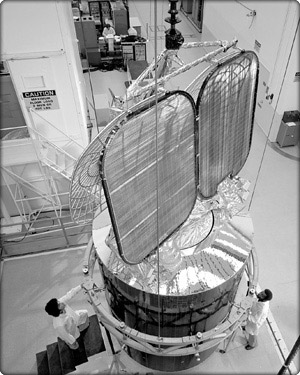

Satellite TV broadcasting, TV Conferencing

COMSTAR Satellite
In the late 1970s the COMSAT corporation had leased transponder space to AT&T and GTE on the COMSTAR satellites. COMSAT was a successful satellite operator who operated INTELSAT satellites at the time, eventually COMSTAT would be purchased by Lockheed Martin years later. COMSTAR satellites were built either in part or in whole by Boeing, and launched in 1976 to support long distance voice communications.
AT&T had several technology choices to carry voice. A long distance system which carried stacked voice channels in a buried waveguide system, a fiber optics solution,a legacy coax cable system ( called L5 I think), microwave radio, and a satellite transport system.
We know today that fiber is the best solution for capacity and cost over waveguide, coax, and infinitely more bandwidth capable than satellites. As Bell Labs and the AT&T business invested in fiber heavily, extra transponder capacity of the satellites became available, and the leases remained on the cost line..
At the same time, the TV networks, who were carrying their signals over microwave links, could benefit from the satellite distribution. This would afford a better consistency of the signal, as well as more flexible uplink and downlink scenarios.
Proposals were made to NBC, CBS, and ABC to modernize their network. The idea was not novel, at the time Scientific Atlanta had already been established as a company, shifting their product line to support the cable head end industry with satellite receivers.
I was present in countless meetings with the three big networks. NBC had a more aggressive engineering team who was willing to take higher risks for the long term. They shifted their strategy to a Ku band satellite network, opting for smaller antenna size. CBS and ABC, on the other hand, were happy with the service provided by AT&T and the then current microwave distribution network, and they opted to continue on course with AT&T.
c.jpg)
Rob Briskman is a satellite industry veteran with countless achievements in the military and satellite industry. His contributions to COMSAT technical review were used by me and other engineers for a number of years. I had no idea at the time that our careers would intersect 20 years later, after he founded Sirius. He remains an inspiring person in my career.
c.jpg)
A mobile setup in a test van was used for a digital TV demo in Las Vegas CES show. T1 modems, 45mb/s T3 modems, equalizers, and TV signal measurement equipment was used. The demo was successful, but worked only hours before our flight departure.
Reaching agreement with the networks would take convincing and understanding of their needs. Systems engineering was needed to support the service availability claims. The size of the antenna, the receivers, the redundancy of equipment would be designed, and I did all the link budgets for this effort. A presence would be needed at the NAB convention show to demonstrate the commitment of the company to these customers. The demos needed some substance to them, as such they always were a nightmare. We had to deal with interference issues, less than perfect RF environments, and we pushed the envelope demonstrating new services. We did the first digital TV demo, by transmitting the video through a set of codecs which had been invented for the Atlanta olympics, through a high speed modem which had been modified. I remember that 24 hours before the demo, nothing worked, and we stayed all night fixing things and took off the next morning for the flight to install the field portion of the demo. In the end, we landed two of the three networks, the daunting efforts paid off.
c.jpg)
Dressed for the times